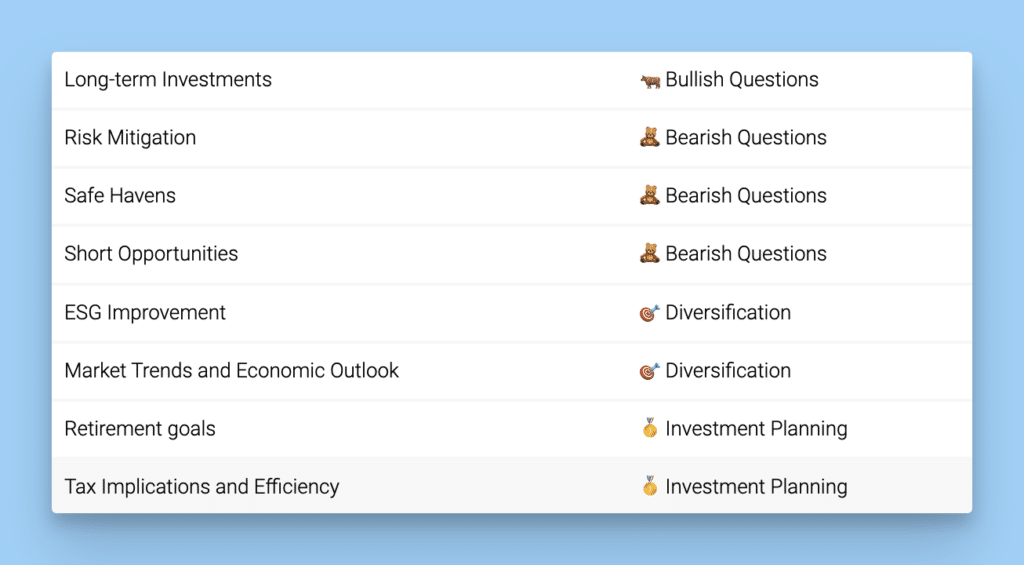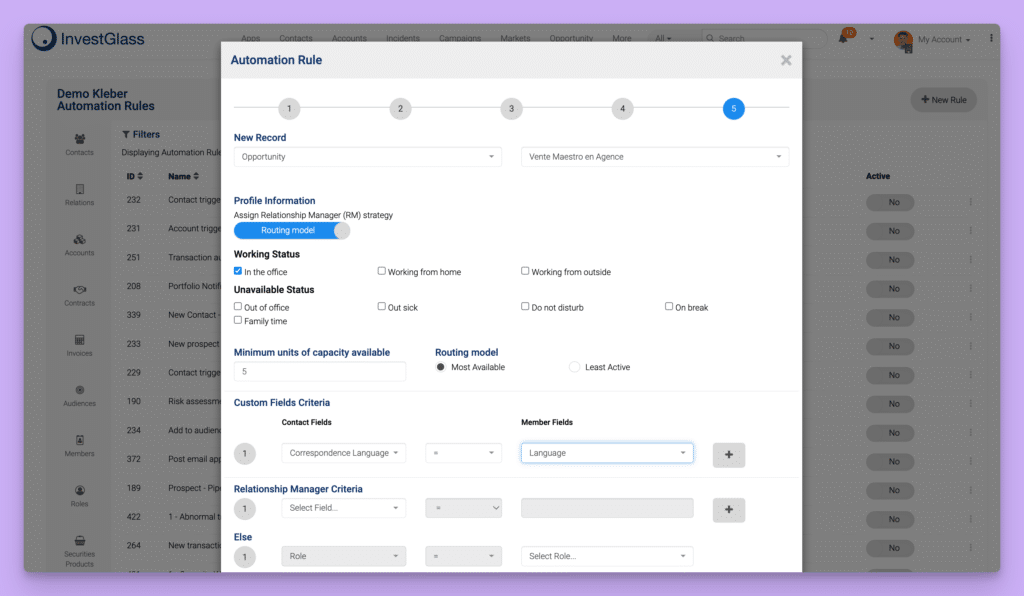Top Tips for Efficient AI Workflow Automation

Tired of drowning in spreadsheets, chasing endless email threads, and feeling like your business processes are stuck in the Stone Age? Enter InvestGlass—the AI superhero- to rescue you from time-consuming manual tasks and workflow chaos.
In this article, we’ll break down what AI workflow automation actually is (hint: it’s not magic, but it’s pretty close), explore its key components, and unveil the game-changing benefits it brings to the table. Get ready to streamline operations, boost productivity, and finally have time for that second cup of coffee.
Key Takeaways
- AI workflow automation enhances operational efficiency by automating repetitive tasks and enabling data-driven decision-making.
- Key components like machine learning, natural language processing, and robotic process automation work together to create a robust automation toolkit.
- Implementing AI workflow automation involves assessing business needs, training employees, and focusing on continuous improvement for sustained success.
Understanding AI Workflow Automation

AI workflow automation involves using artificial intelligence and machine learning. Its purpose is to streamline and optimize various business processes. It encompasses building, analyzing, and continuously improving workflows to enhance operational efficiency and reduce the burden of manual tasks. The significance of AI workflow automation has grown, driven by the need to stay competitive and responsive in a rapidly evolving market.
The adoption of AI workflow automation is accelerating as businesses recognize its potential to enhance efficiency and maintain competitiveness. In 2024, the global workflow automation market was valued at approximately USD 20.3 billion and is projected to reach USD 37.45 billion by 2030, growing at a CAGR of 9.52%.
The COVID-19 pandemic further highlighted the importance of optimizing workflow management, accelerating the adoption of AI-driven solutions across various industries. Automating traditionally manual tasks, AI workflow automation transforms every aspect of business operations, from the shop floor to executive decision-making levels.
AI’s ability to rapidly analyze data leads to better decision-making and allows employees to focus on more strategic work, thus enhancing productivity. As businesses continue to encode more processes into AI systems, the level of autonomous performance increases, further driving efficiency and reducing the potential for human error.
Key Components of AI Workflow Automation with InvestGlass
To harness the power of AI workflow automation, businesses must understand its key components. InvestGlass integrates several advanced technologies to deliver robust automation solutions. These include machine learning, natural language processing (NLP), and robotic process automation (RPA), each playing a pivotal role in the automation landscape.
Machine learning, a cornerstone of AI, involves algorithms that analyze data to provide insights and predictions, continuously improving over time. NLP enables machines to understand and generate human language, facilitating tasks like chat interactions and email categorizations. Lastly, RPA focuses on automating repetitive, rule-based tasks, significantly boosting efficiency.
These components together form a comprehensive AI workflow automation toolkit, streamlining processes, enhancing workflow efficiency, and driving intelligent automation. Each of these technologies plays a crucial role in AI-powered workflow automation.
Machine Learning
Machine learning is the backbone of AI workflow automation. It employs sophisticated algorithms to analyze both structured and unstructured data, enabling systems to learn from patterns and improve their predictions over time. This adaptability makes machine learning incredibly powerful for automating complex workflows and enhancing decision-making processes.
One significant application of machine learning in workflow automation is predictive analytics. Analyzing historical data, machine learning algorithms forecast future trends, enabling businesses to address potential issues proactively and seize opportunities. This capability is particularly valuable in sectors like finance, healthcare, and retail, where accurate predictions can lead to better outcomes.
Moreover, machine learning continuously evolves, adapting to new data and changing conditions within workflows. This ensures that the AI-driven automation remains relevant and effective, minimizing the need for constant human intervention and reducing the likelihood of errors. As a result, businesses can achieve more efficient workflows and make data-driven decisions with confidence.
Natural Language Processing
Natural language processing (NLP) plays a vital role as a key component in AI workflow automation. It enables machines to interpret and generate human language, which is essential for automating interactions and complex processes. NLP applications include chatbots that handle customer inquiries, sentiment analysis for market research, and automated email sorting, all of which enhance workflow efficiency.
Leveraging NLP, businesses enhance their virtual assistant capabilities, enabling more effective communication with customers and stakeholders. This not only streamlines operations but also enhances the overall user experience, making interactions more intuitive and responsive.
Robotic Process Automation
Robotic process automation (RPA) is designed to handle repetitive, rule-based tasks without human intervention. This technology focuses on automating routine activities such as data entry, form filling, and information extraction, significantly improving workflow efficiency. Integrating RPA with AI enables businesses to automate more complex processes and enhance decision-making.
A typical example of RPA in action is automating the processing of invoices. Instead of manually entering data and cross-checking details, RPA tools can swiftly handle these tasks, reducing errors and freeing up valuable employee time for more strategic activities. This not only streamlines operations but also boosts productivity and operational efficiency.
The combination of RPA with other AI technologies like machine learning and NLP allows for a more holistic approach to automation, addressing both repetitive and complex workflows. This integration is key to achieving intelligent automation that can adapt to various business needs and drive continuous improvement.
AI and smart agents AI
AI smart agents are autonomous software entities that perceive their environment and act upon it to achieve specific goals efficiently. These agents often incorporate machine learning, enabling them to adapt their behaviors based on past experiences and evolving conditions. This adaptability makes smart agents highly effective in dynamic environments where conditions can change rapidly.
Smart agents can engage in human-like interactions or interface seamlessly with other systems, using NLP and decision-making algorithms. Applications include chatbots, recommendation engines, and virtual assistants, all of which enhance automation and improve user experiences.
The future potential of these technologies is immense, with transformative impacts expected across various industries.
Benefits of AI Workflow Automation with InvestGlass

The benefits of AI workflow automation with InvestGlass are manifold, enhancing both efficiency and cost savings. By automating complex workflows and repetitive tasks, businesses can significantly improve their operational efficiency. The integration of AI with RPA reduces the need for manual intervention, further boosting overall efficiency and productivity.
Organizations leveraging AI workflow automation tools can achieve substantial cost reductions. It’s estimated that operational costs can be lowered by up to 30% by 2024, thanks to the efficiencies gained from automated processes. Moreover, approximately 60% of organizations are already utilizing workflow automation tools to enhance their analytics and streamline business processes.
Let’s explore these benefits in more detail, starting with how AI workflow automation improves efficiency and productivity.
Improved Efficiency and Productivity
AI workflow automation tools play a crucial role in enhancing operational efficiency. By automating repetitive tasks, these tools reduce the burden of manual work, allowing employees to focus on more strategic activities. This shift not only boosts productivity but also improves overall workflow efficiency.
One of the key benefits of AI-driven workflow automation is the real-time processing of data. This capability ensures that decision-making is based on the most current information, leading to better business outcomes. Moreover, automating repetitive tasks minimizes the risk of human error, which can be costly and time-consuming to correct.
Integrating AI into business operations enhances collaboration and streamlines processes, making it easier for teams to work together effectively. This improved collaboration, coupled with the reduction of manual tasks, can significantly enhance productivity, with some companies experiencing up to a tenfold increase in user productivity.
AI workflow automation tools aid in reducing operational costs. They achieve this by eliminating errors and streamlining processes. Companies that adopt these tools can increase their revenue and efficiency, gaining a competitive edge in the market. Overall, the benefits of AI workflow automation are clear: improved efficiency, higher productivity, and reduced costs.
Cost Savings
AI workflow automation can lead to significant cost savings for businesses. Minimizing the need for large teams reduces salaries and associated expenses such as training and onboarding. Additionally, AI reduces the costs linked to managing and correcting errors, which can be substantial in manual processes.
These savings translate into more efficient resource allocation and better financial health for organizations. Companies that leverage AI workflow automation can reinvest these savings into further innovation and growth, ensuring they stay competitive in their respective industries.
AI for banking
AI has revolutionized the banking sector by enhancing customer experience, improving fraud detection, and personalizing financial services. AI-powered chatbots and virtual assistants provide 24/7 support, answering queries and guiding transactions, thus improving customer satisfaction. Machine learning algorithms analyse complex transaction patterns in real-time to find and stop fraudulent activities and if possible minimising losses.
Personalized financial services are another key benefit, with AI enabling banks to offer tailored products and services based on individual customer needs. Additionally, AI systems evaluate creditworthiness and assess market risks more accurately, thereby enhancing risk management and decision-making.
Let’s delve deeper into how AI improves data analytics in banking.
Better Data Analytics
AI tools significantly enhance data analytics in the banking sector. Automating data processing, AI provides real-time insights, shifting decision-making from intuition-based to data-driven. This capability allows banks to make more informed strategic decisions, such as targeting the right market segments or managing liquidity more effectively.
Moreover, AI-powered intelligent document processing tools can handle unstructured data, including images and handwritten text, thereby improving overall data processing efficiency. This enhancement in data analytics helps banks to gain a competitive advantage in the digital era, ensuring they remain agile and responsive to market demands.
How to Implement AI Workflow Automation with InvestGlass
Implementing AI workflow automation with InvestGlass involves several critical steps. First, it’s essential to assess your business needs, identifying bottlenecks in current workflows that could benefit from automation. Next, integrate AI tools with your existing systems to enhance workflow design and execution capabilities.
Training your team on new AI tools ensures effective use and encourages feedback for continuous improvement. Finally, monitoring and optimizing your workflows regularly will help you achieve and maintain high performance and efficiency. These steps can be broken down further.
Assess Your Business Needs
Before:
The first step in implementing AI workflow automation is to thoroughly assess your business needs. This involves creating a task map to enhance visibility and understanding of your operational processes. Identifying repetitive tasks is crucial for determining which processes can benefit most from automation.
After:
- Thoroughly assess your business needs.
- Create a task map to enhance visibility and understanding of your operational processes.
- Identify repetitive tasks to determine which processes can benefit most from automation.
Launching small pilot projects for AI automation allows organizations to test the feasibility of their initiatives before expanding them. This approach helps manage risks and ensures that the solutions implemented will be effective and scalable.
Integrate AI with Existing Systems
Integrating AI with existing systems is a vital step in implementing workflow automation. API integrations are essential for ensuring seamless communication between AI tools and your existing software platforms.
Start by integrating systems that require minimal changes to reduce disruptions and ensure a smooth transition. This approach enables businesses to leverage the full potential of AI without overhauling their entire IT infrastructure.
Train and Onboard Your Team
Training and onboarding your team are crucial steps in the successful implementation of AI workflow automation. Open communication throughout the training phase helps address initial obstacles and ensures that everyone is on the same page. Creating an environment that encourages experimentation with AI technologies can boost employee engagement and lead to innovative solutions.
Promoting an innovative mindset among employees is essential for the adoption of new systems. When team members feel safe to experiment and explore AI tools, they are more likely to embrace these changes and contribute to the continuous improvement of workflows. This culture of innovation is vital for maximizing the benefits of AI automation.
Monitor and Optimize Workflows
Once AI workflow automation is in place, monitoring and optimizing workflows is an ongoing process. Establishing key performance indicators (KPIs) is essential for effectively tracking the performance of AI workflows. Comparing process times and outcomes to previous methods helps measure success and identify areas for improvement.
Regularly gathering feedback from your team is crucial for optimizing AI workflows. This feedback can reveal areas that need enhancement and ensure that automated processes remain aligned with business goals. Continuous measurement and adjustment of workflows are necessary for sustained success and efficiency.
Use Cases of AI Workflow Automation

AI workflow automation is transforming numerous industries. It enhances operational efficiency and enables smarter decision-making. Identifying specific pain points promotes efficient AI integration into daily workflows.
Let’s explore some industry-specific use cases, starting with healthcare, retail, and banking.
InvestGlass AI for Healthcare
InvestGlass offers an advanced AI solution designed to revolutionize the healthcare industry by automating critical workflows. From appointment scheduling to medical records management, InvestGlass streamlines administrative tasks, reducing wait times, improving patient satisfaction, and enhancing operational efficiency. By automating data entry and record handling, healthcare professionals can focus more on delivering quality care rather than managing paperwork.
Beyond administration, InvestGlass leverages AI to support diagnostic workflows by analyzing medical images and test results. This capability not only improves diagnostic accuracy but also reduces the workload on healthcare teams, enabling better patient outcomes while maintaining operational excellence.
InvestGlass AI for Retail
InvestGlass brings AI-powered workflow automation to the retail sector, empowering sales and marketing teams to work smarter. By automating lead generation, qualification, and prioritization processes, InvestGlass ensures businesses can better identify and target potential customers. This results in optimized sales cycles, improved efficiency, and enhanced customer experiences, driving sustainable growth in a competitive retail landscape.
InvestGlass AI for Banking
In the banking industry, InvestGlass delivers robust AI solutions to streamline workflows, enhance security, and improve service delivery. By automating fraud detection and transaction monitoring, InvestGlass helps financial institutions mitigate risks and safeguard customer assets.
Additionally, InvestGlass simplifies loan processing by automating credit checks and document verification, reducing turnaround times and minimizing errors. With AI-driven precision, banks can enhance their customer experience, ensure compliance, and drive operational efficiency.
Choosing the Right AI Workflow Automation Tool

Selecting the right AI workflow automation tool is crucial for successful implementation. Considering the tool’s ability to streamline processes and enhance efficiency is important. Collaboration with your IT team or the tool vendor’s support can be invaluable in ensuring effective integration.
User-friendly tools with features like a visual editor and drag-and-drop capabilities can enhance adoption rates and ensure smooth implementation. Additionally, the right tool should offer seamless automation, customizable workflows, and an intuitive interface to facilitate quick workflow creation.
Identify Pain Points
Identifying pain points is the first step in choosing the right AI workflow automation tool. Recognizing specific challenges within your workflow allows you to target inefficiencies and outline where AI automation can add the most value. This targeted approach leads to more effective and impactful automation solutions.
Organizations should identify their needs, whether internal or external solutions are required, and any bottlenecks or gaps in workflows before implementing AI workflow solutions. This preparation ensures that the chosen tool addresses the most critical areas and delivers maximum benefits.
Evaluate Features
When evaluating AI workflow automation tools, consider key features such as low-code/no-code options, a visual editor, and drag-and-drop capabilities. These features facilitate quick and easy workflow creation, reducing costs and time spent on tasks.
An effective ai automation tool for workflow automation should also offer a visual editor with drag-and-drop capabilities to streamline the process of building and modifying workflows. This user-friendly design ensures that even non-technical users can efficiently create and manage automated workflows.
Integration Capabilities
The integration capabilities of AI workflow tools are critical for seamless operation. Most companies use 40 to 60 different SaaS applications, so choosing tools that can work seamlessly with existing platforms is essential to minimize disruptions.
Effective workflow automation tools should facilitate easy integration with various existing software platforms, ensuring better operational efficiency and reduced manual errors. This connectivity leads to smoother transitions and more effective automation.
Best Practices for AI Workflow Automation

Implementing AI workflow automation requires careful planning, execution, and creativity. Following strategic best practices is crucial for effective implementation and sustained success.
Let’s explore best practices including starting small, continuous improvement, and fostering a culture of innovation.
Start Small and Scale Up
Starting with simple processes helps organizations manage change more effectively. Implementing AI workflow automation in a structured approach ensures success and minimizes risks. Streamlining business processes by assessing the complexity of tasks before automating enhances implementation outcomes and scalability.
Monitoring AI workflows and gathering feedback is critical for optimizing automation and understanding its scalability. Starting small and gradually increasing the scope of automation leads to improved efficiency and productivity.
Continuous Improvement
Regular assessment and fine-tuning of automated workflows ensure they remain effective and aligned with business goals. Ongoing evaluation of workflows helps them adapt to changing organizational needs and maintain their efficiency over time.
Regularly reviewing automated workflows helps identify areas for enhancement and keeps processes aligned with changing business needs. This continuous improvement approach is essential for maintaining the benefits of AI workflow automation.
Foster a Culture of Innovation
Training employees on new AI tools is crucial for fostering innovation. Ensuring they understand and can effectively utilize these technologies in their workflows promotes a culture of innovation.
Beginning with simple processes allows organizations to gradually scale up their automation efforts, encouraging employees to become comfortable with AI technologies. This continuous optimization of AI workflows fosters a culture of innovation and enhances productivity.
Summary
In summary, AI workflow automation offers transformative benefits by enhancing efficiency, reducing costs, and improving decision-making. Key components like machine learning, NLP, and RPA work together to create intelligent automation systems that streamline business processes and reduce manual tasks.
Implementing AI workflow automation with InvestGlass involves assessing business needs, integrating AI with existing systems, training your team, and continuously monitoring and optimizing workflows. By following best practices and fostering a culture of innovation, businesses can leverage AI to achieve sustained success and a competitive edge. Embrace the power of AI and transform your workflows for a more efficient and productive future.
Frequently Asked Questions
What is AI workflow automation?
AI workflow automation is an exciting way to boost efficiency by using AI and machine learning to streamline business processes and minimize manual tasks. Embracing this technology can lead to a more productive and innovative work environment!
How does machine learning contribute to AI workflow automation?
Machine learning significantly enhances AI workflow automation by analyzing data to generate insights and predictions that improve decision-making. This continuous learning process allows for the automation of increasingly complex tasks, making workflows more efficient and effective.
What are the benefits of AI workflow automation in healthcare?
AI workflow automation in healthcare significantly enhances efficiency by streamlining administrative tasks and improving medical records management, leading to reduced wait times and better diagnostics. Embracing this technology can transform patient care for the better!
How can businesses choose the right AI workflow automation tool?
To choose the right AI workflow automation tool, businesses should identify their pain points and prioritize user-friendliness and integration capabilities. This thoughtful approach ensures the chosen tool will enhance efficiency and fit seamlessly into existing systems.
What are some best practices for implementing AI workflow automation?
To successfully implement AI workflow automation, start small and scale gradually while continuously assessing and improving your processes. By fostering a culture of innovation among your team, you’ll unlock even greater potential for efficiency and creativity!